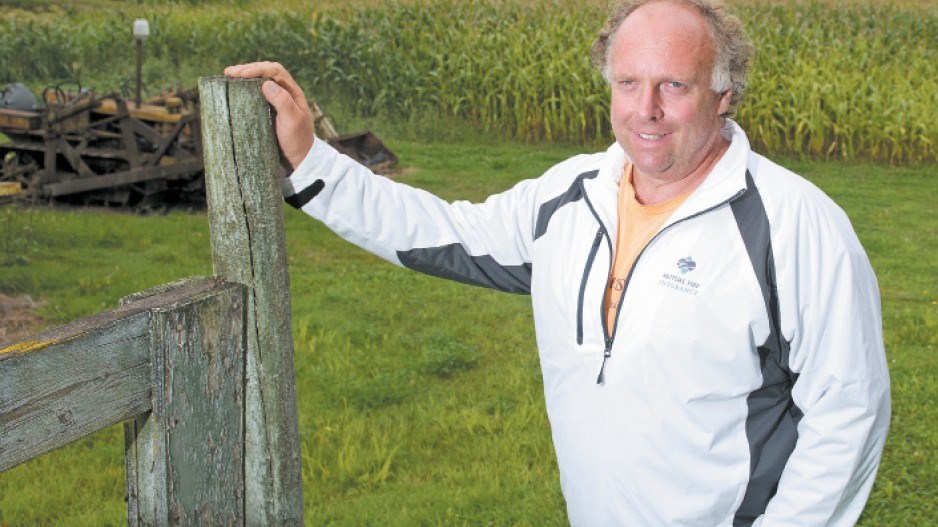For a quarter of a century Mike Bose lived in his grandfather’s historic farmhouse off Surrey’s 64th Avenue perched atop a hill with sweeping views of the North Shore mountains and acres of lush fields.
That vantage point also gives the entrepreneurial farmer an overview of the area’s dramatic changes.
“We could see the highrises in north Surrey up at Central City,” Bose said.
For Bose, whose family has farmed in the area for 120 years, change has come closer to home. Condos are now being built on the site of the family’s historic homestead; old farmers are retiring, their vegetable fields giving way to new owners’ blueberry farms; and access to markets has been reduced as fewer farmers mean less organized marketing and limited access to potential buyers.
“It really hurts. My family has been here since the beginning of Surrey, and we’ve always produced,” said Bose, as he sat under a tent at his family’s well-known corn maze on a recent rainy morning. “The reason that I farm is that I have a passion for producing foods for people, and it’s what my family has always done. And it really bothers me that we’re losing that production.”
That’s why he applauds Surrey’s recently released agriculture strategy, which is designed to protect and enhance the local industry’s growth, viability, profitability and sustainability.
Focusing on five key priorities – land base, innovation, infrastructure, agri-urban connections, and sustainability and resiliency – the plan was developed in consultation with the city’s Agriculture and Food Security Advisory Committee. Bose, who wrote the committee’s terms of reference, is now its vice-chairman.
Without the plan, there would be a greater dependence on foods from outside Canada, said Bose, who grows corn and raises turkeys at his farms.
Surrey’s approximately 550 farmers grow more than 450 varieties of agri-crops, mainly forage crops for dairy, which has overtaken vegetables. Blueberries are now the area’s second largest crop yield.
Bose said Canada’s vast land set aside for food production “is good for nothing” without the right soil, climate, day length and water abundance, all of which Surrey has.
“Yes, we have a vast land [base], but we have a limited land in this country that will produce the foods that we need to survive. So this strategy and strategies like it that are going to preserve our agricultural base are very important as we go through the next millennium. The No. 1 barrier to agriculture is the cost of land, and as good development lands gets developed in Surrey, there’ll be growing pressure to get agriculture land for development.”
Surrey mayor Dianne Watts says the city is exploring new technologies in food production and different ways to grow crops. The city also wants to know who the next generation of farmer and farm worker will be.
“When you look at the question you need to realize that there has to be an evolution in farming,” Watts said.
However, with agriculture making up a third of the land base, there have been some challenges ensuring that all agricultural land is used for farming. Watts said trucks are parked on some farmland, land is bought but not farmed and some people want to pull land out of the agricultural land reserve.
She said the city will release developments around the plan over the next few months, including how it can help beekeepers. Research has shown that some herbicides and pesticides are killing the bees.
“You can’t have agriculture and crops if you don’t have bees,” Watts said.
Strategies to help encourage local processing of products, and innovation, will also help grow the industry.
Bose said the city has worked well with the committee over the past 16 years. “They’re seriously looking at the economic impact that agriculture has on Surrey and giving agriculture the respect it needs and working very hard to help improve it.”
Surrey’s five-point strategic agriculture plan:
Land base
The focus is on protecting farm operations from urban impacts, curbing and eliminating illegal activity on farm land, supporting increased food production, and preserving agricultural land for farming.
Innovation
Prioritizing the use of smarter, more sustainable food growing and production systems and supporting farmers who want to diversify their crops and expand into new markets.
Infrastructure
This strategic direction focuses on the ongoing improvement of lowland drainage, ensuring existing and future transportation networks do not impede agricultural operations, and reviewing existing policies and regulations to ensure that they do not inadvertently place financial or operational barriers on farm operations.
Agri-Urban connections
Building public agriculture awareness through campaigns, connecting residents with Surrey farmers to provide a link with locally grown food, connecting school programs with local agriculture, and supporting food systems that encourage healthy local diets.
Sustainability and resiliency
Encourages farmers to operate in ways that support biodiversity, support the diversification of crops and agricultural operations and develop emergency management strategies that allow the agricultural industry to respond and adapt to unpredictable climate fluctuations.




